Getting Started with OnePager Pro Version 5.3 Desktop
Contents
- 1 Overview
- 2 Launching OnePager Pro for the First Time from the Desktop
- 3 Creating a New Project View
- 4 Options on the New OnePager Choices form
- 5 Adding a New Source File
- 6 Removing a Source File
- 7 Other Choices to Make
- 8 Making the Graph
- 9 Opening a Project View
- 10 Updating a Project View with Changes Made to the Microsoft Project Source File Data
- 11 Adding a Snapshot to a Project View
- 12 Editing the Project View
- 13 Copying the Project View to PowerPoint
Overview
As mentioned in the article What's New with OnePager Release 5.3?, OPP can now be launched from a desktop icon as well as from within Microsoft Project.
This article covers the “Getting Started” process when you launch OPP from the desktop.
The article which provides Getting Started guidance when launching OPP from Microsoft Project is at Getting Started with OnePager Pro Add-in.
Launching OnePager Pro for the First Time from the Desktop
1) OPP version 5.3 may be installed so that it can be launched either from Microsoft Project’s Add-in tab on its tool bar or from a desktop icon or both. Additionally, you may also locate and double-click a .TAM file to bring up the desktop OPP version 5.3.
2) The desktop icon for launching OPP version 5.3 looks like this:
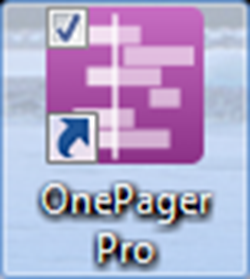
3) Before you launch OPP from the desktop, it is a good idea to unhide the Microsoft Project flag column you intend to use in your Microsoft Project source file. Note that when you unhide a column in Microsoft Project, that column may now appear in some of Microsoft Project’s standard reports. Do not forget to hide the column again before generating such reports if you do not want the column to appear in those reports. The selected flag column allows you to control which tasks get graphed and to store those choices in Microsoft Project for future use. An example of the use of a flag field (e.g., Flag20) is shown below:
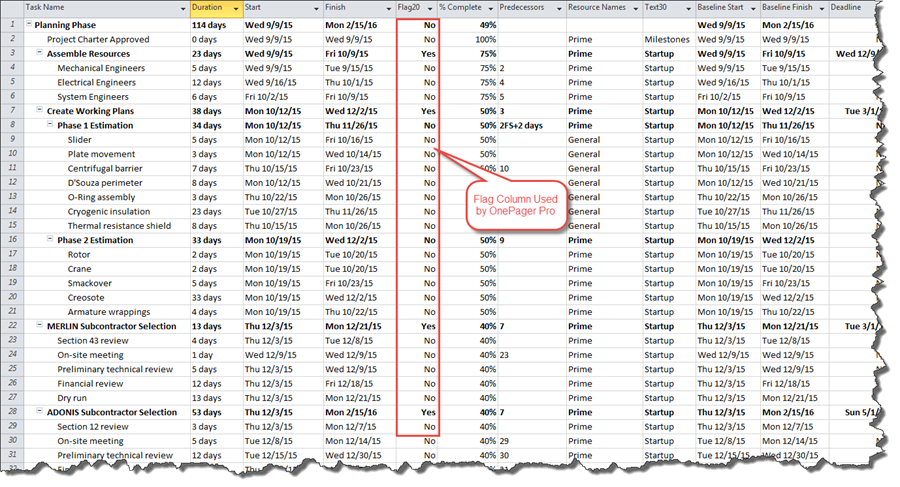
4) To control which tasks get graphed, specify the Microsoft flag column (e.g. Flag1, Flag2 … Flag20) that you wish to use. Number fields may also be used the same as the flag fields where a 1 in a Number field indicates Yes and a 0 in a Number field indicates No. Unhide that column in Microsoft Project by right-clicking in the column header area and selecting Insert Column:
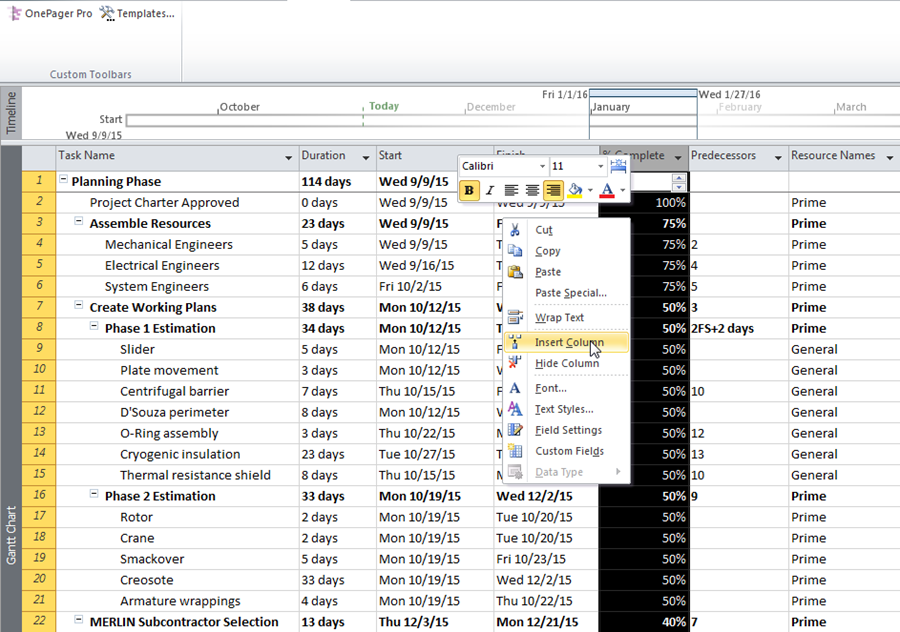
5) Now put a Yes in this flag column for any task that you want to graph:
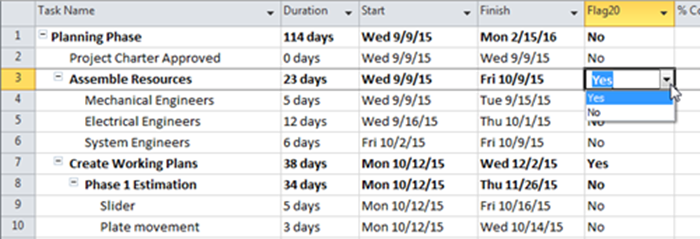
- a) When making your first project view, we strongly recommend that you mark 50 or fewer tasks with Yes.
- b) Please note that OPP is shipped with a number of fully populated templates that are based on the Microsoft Project file used in the tutorial also shipped with the product – BlueGrass Project 2J-303.
- c) Starting in Microsoft Project 2010, there is a Manual Scheduling mode that allows you to leave dates blank in your schedule. However, behind the scenes, these dates are still being automatically assigned to the project Start Date, or to Today's Date if the project Start Date is not defined. Even though the dates appear to be undefined, they are defined behind the scenes, and are being passed to OPP. Because Today's Date often equals your Snapshot date, it is not surprising to see all of these dateless tasks appearing near the time cursor.
- d) There are two solutions to this issue:
- (1) Define the dates for your tasks and milestones in Microsoft Project. This will overwrite any default dates that Microsoft Project is assigning, and will make your project schedule more consistent with your OPP timeline.
- (2) Remove the dateless tasks from your OPP graph. You can leave them in project, but by removing them from the OPP graph, you won't have to explain why certain tasks/milestones are appearing in weird places when they really should not. As a rule of thumb, we recommend defining dates for all tasks and milestones, especially when it comes to graph generation.
6) Clicking the OPP icon on the desktop will first display a splash page and then take you to the Project View Editor (PVE).
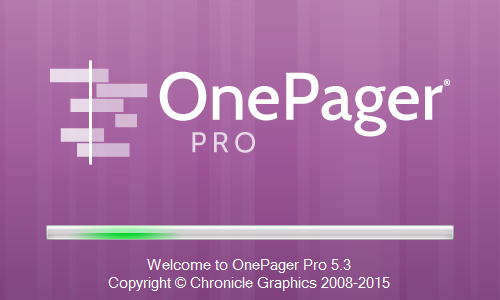
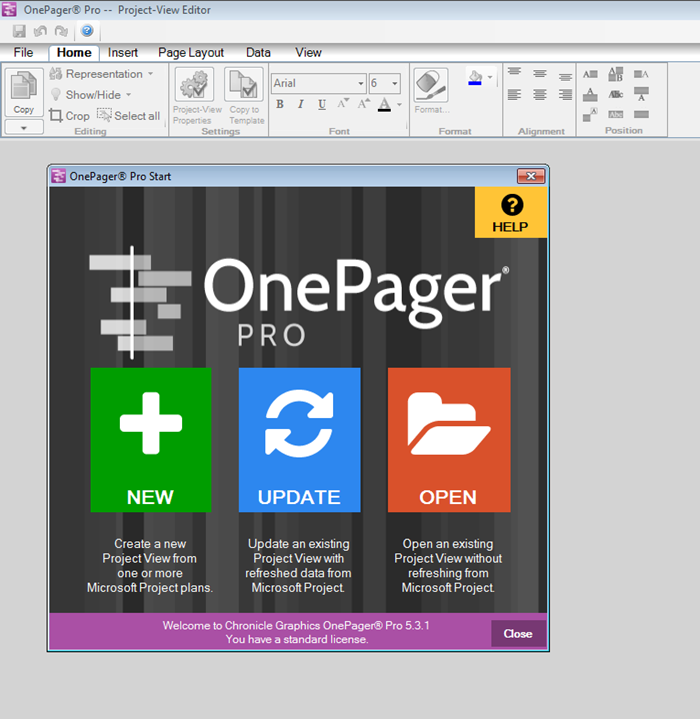
7) The OnePager Pro Start form provides you with three options:
- a) NEW Clicking the NEW button will bring up the OnePager Pro choices (OPC) form.
- b) UPDATE Clicking the UPDATE button will allow you to BROWSE FILES for an existing project view file or select a recently-opened project view file.
- c) OPEN Clicking the OPEN button will allow you to BROWSE FILES for an existing project view file or select a recently-opened project view file. Once selected and opened, the project view is available for editing.
Creating a New Project View
8) Clicking the NEW button brings up the OPC form as shown below:
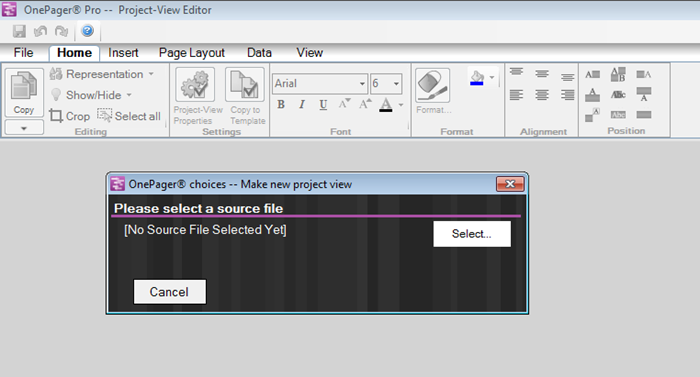
Options on the New OnePager Choices form
9) We’ve enhanced the OPC form to give you more options for selecting source files. The illustration above shows that OPP was initiated from the desktop icon with no Microsoft Project source file specified. The Select button gives you the capability to select the Microsoft Project source file or files that you want to use to create a project view.
- a) Clicking the Select button displays a dropdown menu with a BROWSE FILES... option as well as a list of recently accessed Microsoft Project source files as shown here:

- b) If you select the BROWSE FILES... option, a Windows Open form appears from which you can select the desired Microsoft Project source file for OPP to use as shown below:
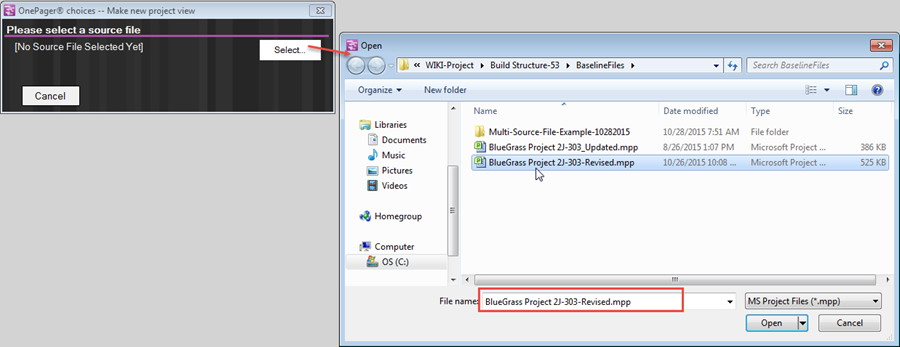
- c) When you select the Microsoft Project source file and click the Open button on the Windows Open form, OPP loads the Microsoft Project source file selected and expands the OPC form as shown below:
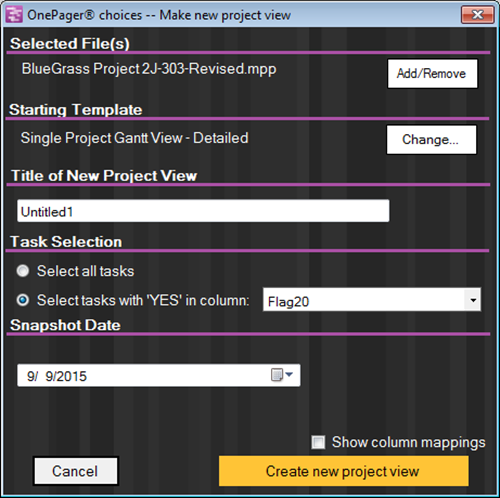
Adding a New Source File
10) At this point you have additional options to use the expanded OnePager choices form, specifically the Add/Remove button. The Add/Remove button gives you the capability to add more files to the source packet or, for multiple files to remove files if desired.
- a) Clicking the Add/Remove button brings up the Data source selection form as shown below:
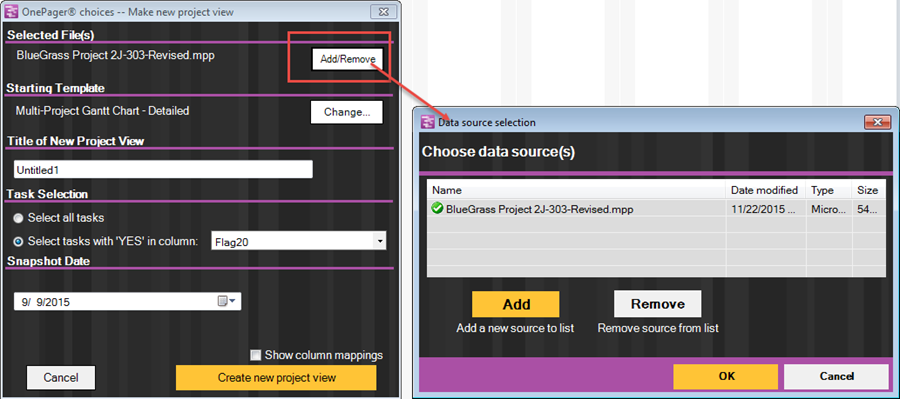
- b) The Data source selection form displays the current source file that was loaded with Microsoft Project data when you clicked the OPP button on the desktop and selected the first file as described above. This form lets you Add more Microsoft Project source files to create a multi-project project view or Remove a file from a multi-file source packet. These options are detailed below.
- c) Add a new source file to the source packet When you click the Add button, OPP will give you the option to bring up a Windows Open form when you select the BROWSE FILES… option as shown here:
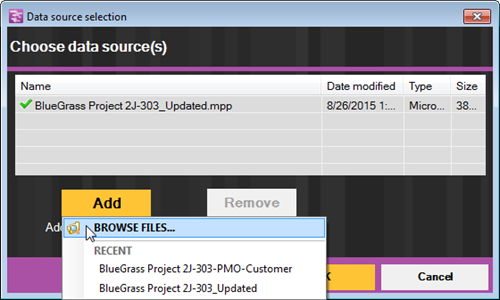
- i) Clicking the BROWSE FILES… option will display a Window’s Open form from which you may select a Microsoft Project file to add to the source packet. A sample Open form is shown below:
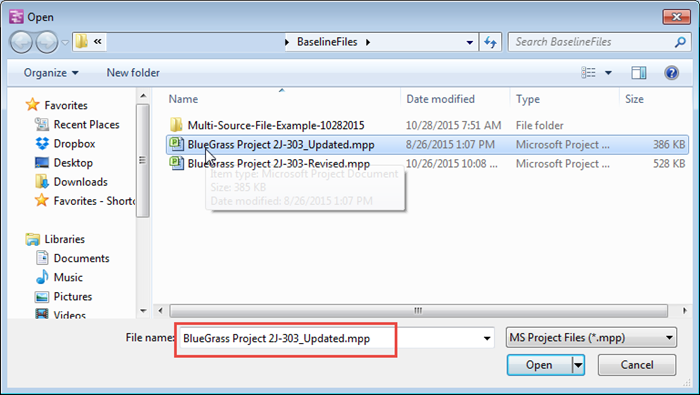
- ii) When you select a desired Microsoft Project source file and click the Open button as shown above, OPP will add the file to the source packet and display it in the Data source selection window as shown below:
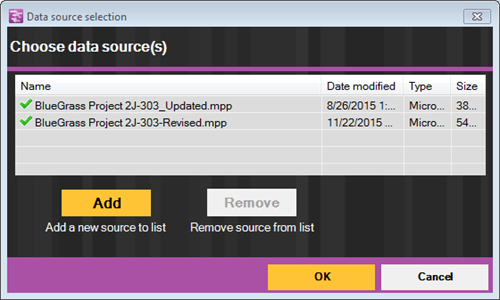
- iii) The selected file is added to the source packet as shown above. OPP shows the path name of the files in the window if you hover the mouse over the file name.
- iv) If you select a recently used file from the dropdown menu displayed with the Add button is clicked in the Data source selection form, OPP will add that file to the source packet.
Removing a Source File
- d) Remove source from source packet The Remove button allows you to remove a source file from a source packet if that file is not needed to create the new project view. To remove a file, first select the file in the Data source selection form’s window so that it is highlighted in blue then click the Remove button as shown in the sequence below:
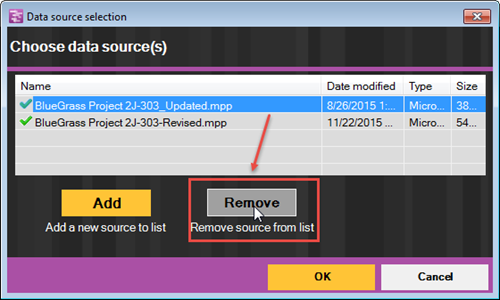
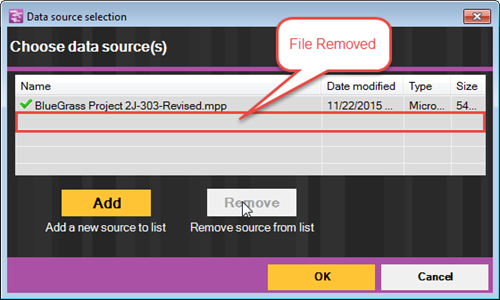
Other Choices to Make
11) Moving on to the other sections of the OPC form, you are asked to confirm a few things before you build the project view. OPP will make good guesses for each of these choices, but you can change any of them:
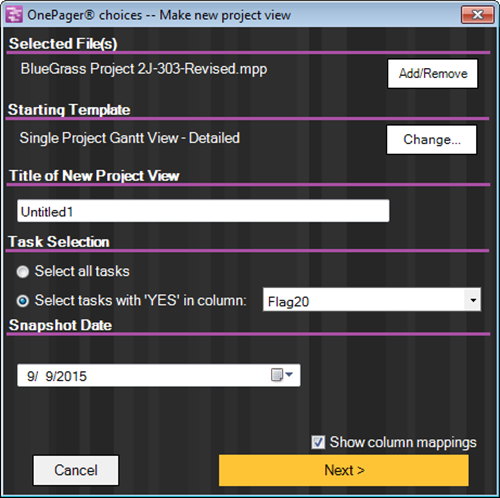
- a) Starting Template The current template determines which columns get imported from Microsoft Project and how the initial project view looks. OPP ships with many sample templates, but you can also customize your own templates.
- i) To choose which template to use in building your project view, click the Change… button in the top group of the OPC form.
- ii) For now, just stick with the default template entitled Single Project Gantt View – Detailed, but you can always use a different template to get a different type of project view.
- b) Title of the New Project View This is the title of the graph and also the suggested save file name. You can change the file name when you save it. We recommend that you enter a title that helps you identify the view later on.
- i) For each project view that you create, OnePager remembers colors, titles, legends, font sizes, and all other graph properties so that your work is saved.
- ii) Later, you can update the project view with a snapshot of how the project looks on a different date. Then you can browse through the snapshots to see how the project is changing over time.
- iii) OPP version 5.3 also saves the path name associated with the file (.TAM). Path names are not available in .TAM files produced with previous version of OPP.
- c) Task Selection This is how you tell OPP which tasks from your Microsoft Project plan to include. Either click the Select all tasks radio button to graph everything or choose a flag column. You can make several project views from a single Microsoft Project plan, each using a different flag or number column. In OPP version 5.3 if no flags are set to Yes, OPP will provide the user with a warning message.
- d) Snapshot Date: This is the date of the report and lets you keep track of how schedules change over time. Each project view can have several snapshots.
12) Since the Show column mappings button near the bottom of the form is checked, you now have a chance to review and change the Microsoft Project column mappings to OPP before you make your first project view. To do this, click the Next> button. You now see the following form:
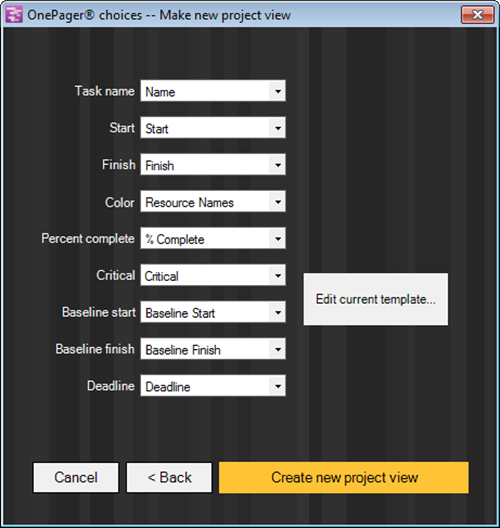
13) Notice in the form above that OPP has relied on the current template to make some guesses on what Microsoft Project columns should be used in making the graph. You can easily change any of these column mappings by making selections from the dropdown menus. For example, we show below how to change the Finish Date :
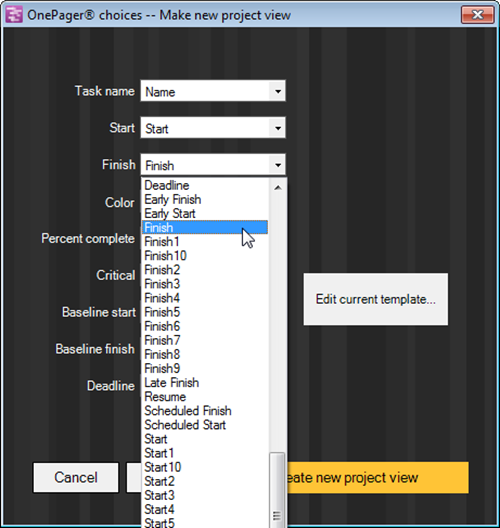
Making the Graph
14) Once you are satisfied with the column mappings, click the Create new project view button to import your selected data and create a project view. After a second or two you will see a screen that looks like this:
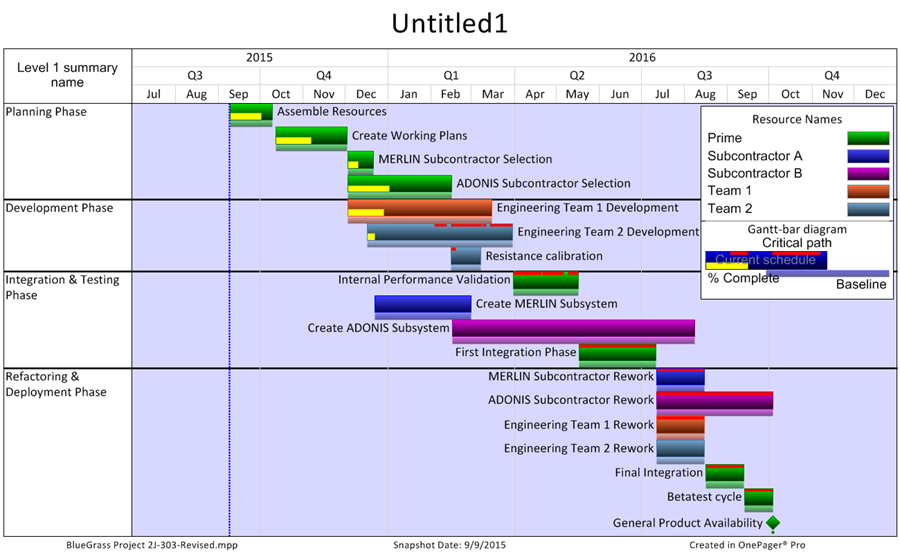
15) Note that each task or milestone was color coded based on the value in the Resource Names column.
- a) The legend contains an optional diagram near the bottom explaining that the bars inside the Gantt bars represent percent complete extracted from Microsoft Project.
- b) Percent complete comes from a Microsoft Project column that you specified in the column mapping form
- c) Note that the current template, when you press the Create new project view button, is the template for how things look in the new project view. The template’s Task Bars tab showing where the color control is located is shown below:
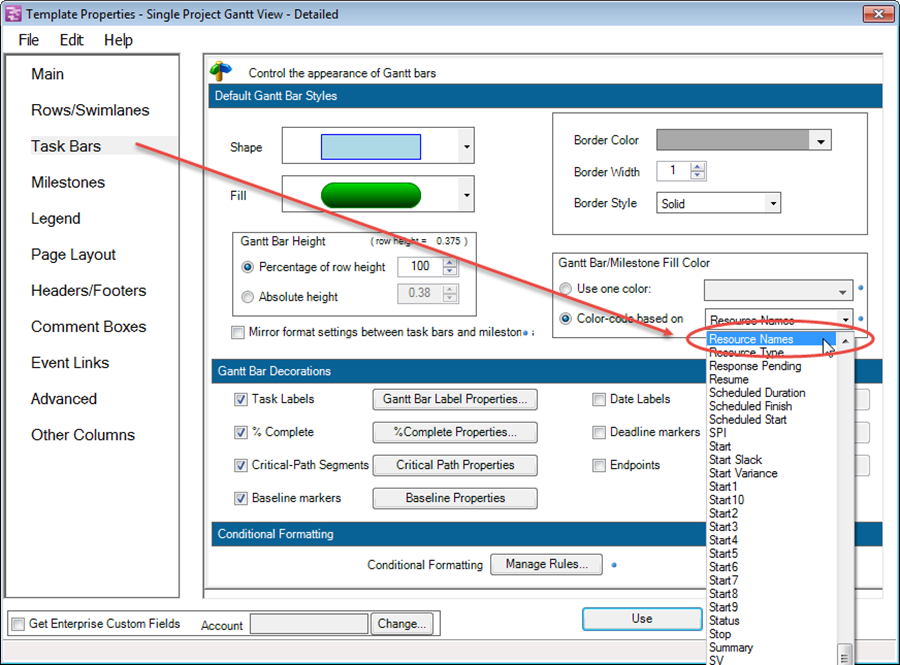
Opening a Project View
16) The right-most button on the OPC form is the OPEN button. Clicking the OPEN button displays a dropdown menu which happens to be the same for the NEW and UPDATE buttons. The options in the dropdown are discussed below:
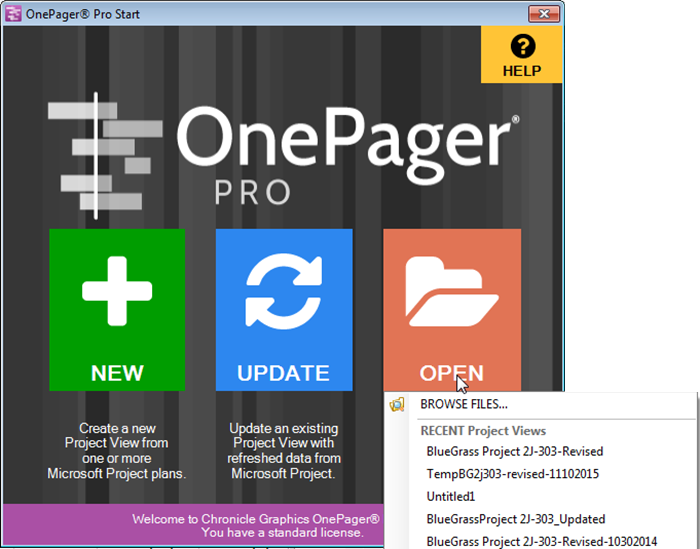
- a) Clicking the BROWSE FILES... option will bring up a Windows Open form from which you can select a .TAM file that you want to open. Selecting the desired .TAM file will cause OOPP to display the selected project view. From this position, you may edit the project view, save it, or share it with others.
- b) Clicking any of the RECENTproject views items in the dropdown menu above will cause OPP to load the associated .TAM file into the Project View Editor (PVE) where you may also edit the project view, save it, or share it with others.
Updating a Project View with Changes Made to the Microsoft Project Source File Data
17) Suppose after examining the project view you created before, you realize that it would be best to show more task bars. This, you think, would greatly improve the schedule discussion you are about to attend. Updating the project view at this point is a simple matter. Recall that OPP is active and the PVE is displaying the current project view you want to update. Additionally, the Microsoft Project source file and the application are active. The original project view looked like this:

- a) Since Microsoft Project is still an active program and the Microsoft Project source file you are using is still being displayed, go back to the Microsoft Project application and change the Flag20 column setting for the rows you want to now display from No to Yes. A section of the Microsoft Project source file where this is done is shown below:

- b) Once you’ve made the Flag20' changes lines 8 through 15 in the Microsoft Project the source file will look like this:

- c) With the Microsoft Project source file updated, go back to OPP and navigate to the Data tab on the ribbon where you’ll see several buttons. To update your project view to show the additional rows from your Microsoft Project source file. click the Replace Snapshot button as shown below:
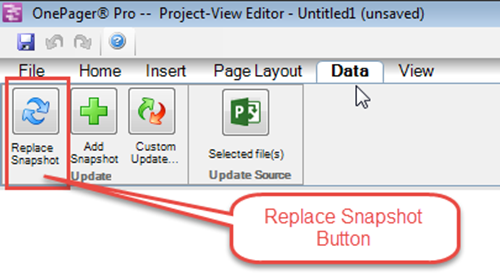
- d) When you click the Replace Snapshot button, OPP will go back to the associated Microsoft Project source file that you just changed, bring in all the rows that changed, and update your project view.
- e) At the conclusion of the operation, the updated project view will look like this:
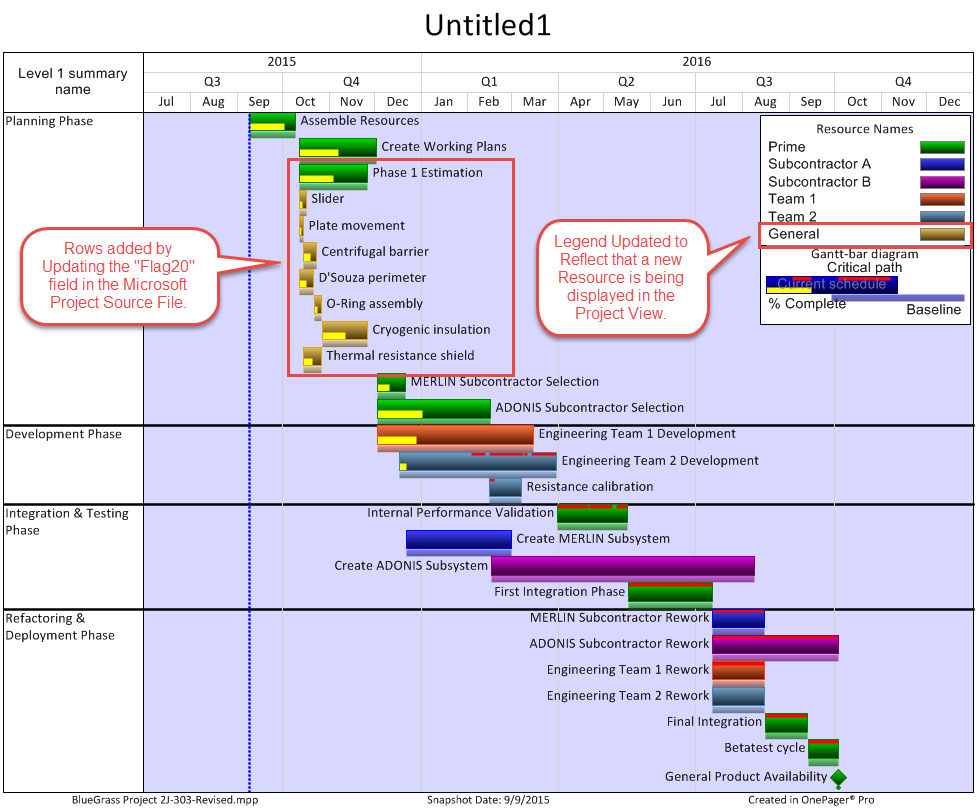
18) The example above is just one of many uses of the Data tab’s Replace Snapshot button when you need to update a project view. And, you can do this as many times as necessary until the project view is the way you need it. In addition to adding and removing rows by changing the Flag20 field, you may need to change Start Dates, Finish Dates, or Percent Complete and display these data changes in the project view. Using the procedure above you can do this very efficiently.
19) At this point you may save the project view by giving it a file name. When you save the project view in OPP, OnePager will save the .TAM file and within will save the Microsoft Project file name and path information. This is useful when you want to further update the project view or when you want to add a snapshot later on. In the examples below we will assume that the project view was saved as BlueGrass Project 2J-303-Revised.
Adding a Snapshot to a Project View
20) The power of OPP is illustrated when, after a period of progress on the project, it is time to produce another project view, with the same look and feel. Assuming that the Microsoft Project plan was updated with actual start and finish, percent complete, and other relevant data during the reporting interval, OPP can easily generate a new snapshot. Launch OPP either from Microsoft Project or from the desktop icon and click the UPDATE button on the OnePager Pro Start form. Doing so will bring up the following OnePager choices (OPC) form:
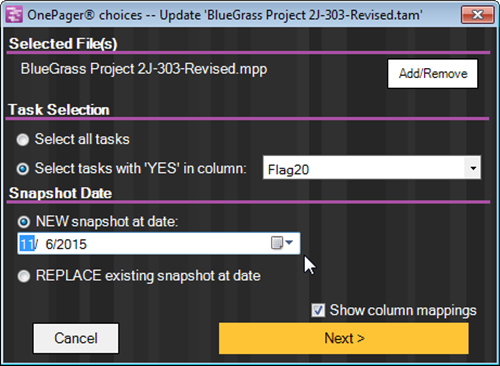
- a) In the OPC form select the NEW snapshot at date: as shown above. You will want to select a current date for the snapshot so that this snapshot will represent the project at the status date point in time. To see which snapshot dates already exist, just position your mouse over the NEW snapshot-date: window to see a list of the existing dates. Use the built in calendar dropdown or type in the new snapshot’s month, day, and year in the window provided as shown below:
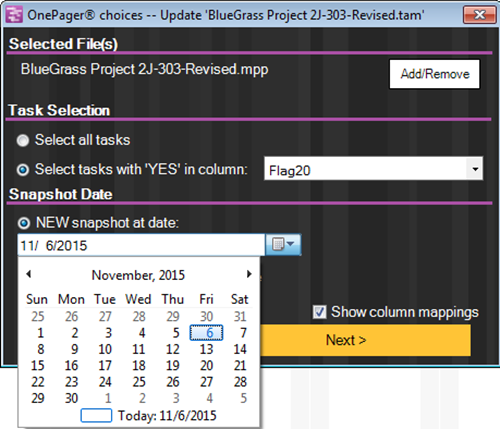
- b) Uncheck the Show column mappings' checkbox if you want to use the same mappings as you used before. The bottom of the screen now looks like this:

- c) Pressing the large New button creates a new snapshot for the project view. The project view opens at the new snapshot. The color, fonts, title, and swimlane assignments are consistent between the two snapshots:
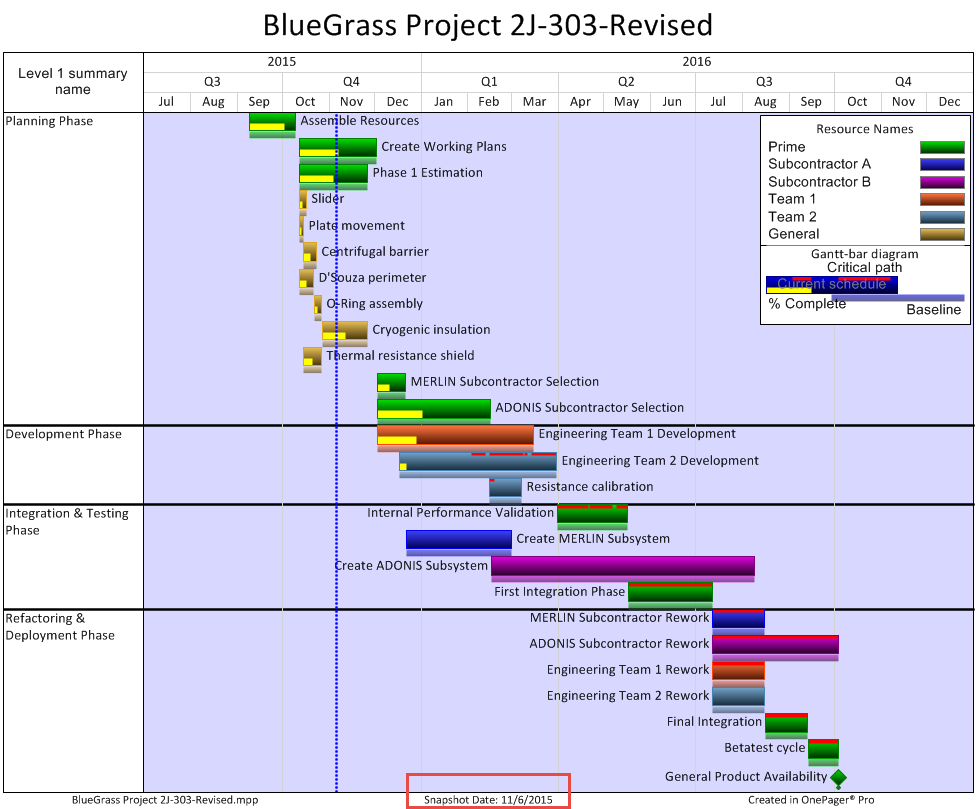
- d) You can go back and forth between the two snapshots by using the snapshot forward/backward buttons on the View tab as shown above:
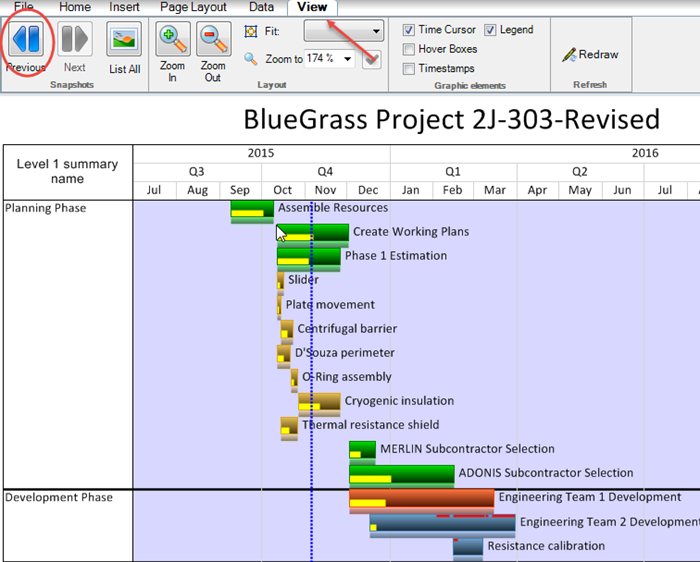
Editing the Project View
21) Sooner or later, most of you will edit the font sizes' and text position to optimize readability. To do this, hold down the left mouse button and drag a selection box that encloses many tasks/milestones at once:
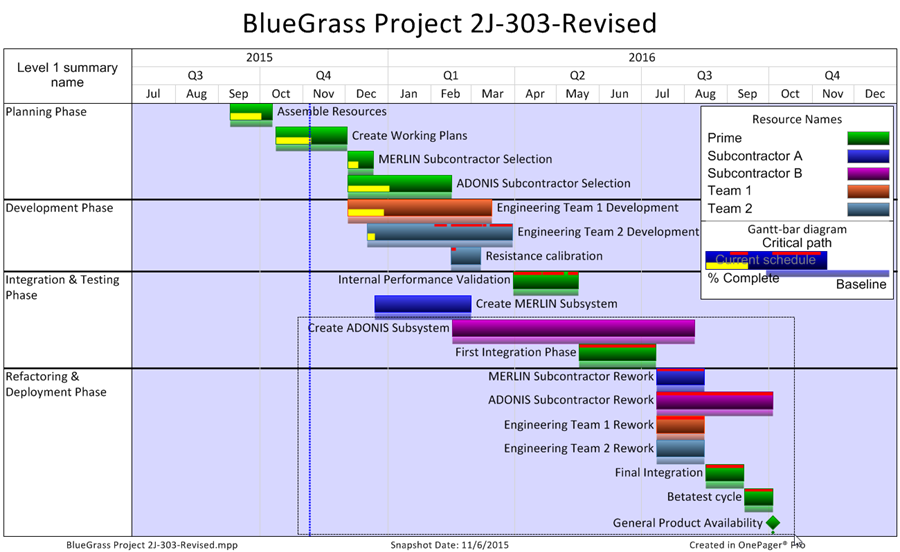
- a) When you release the mouse, the enclosed tasks/milestones will all be selected:
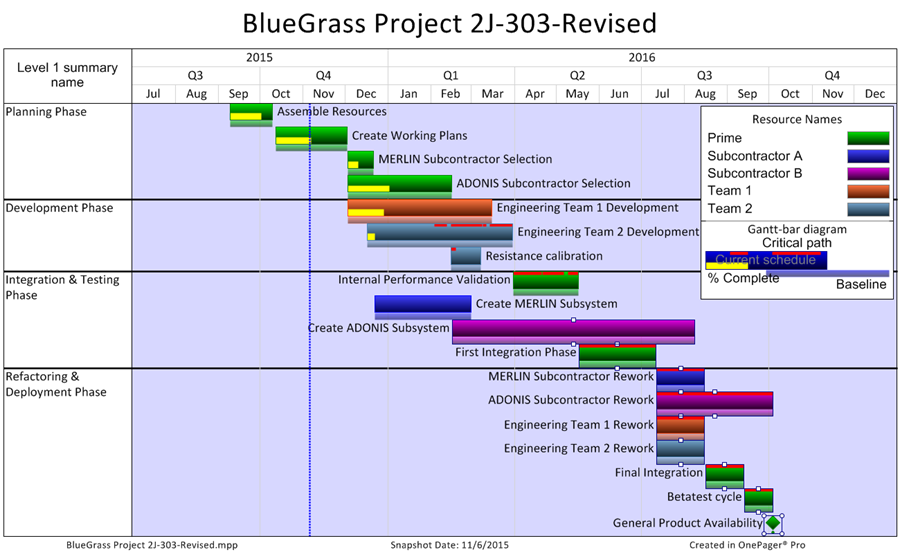
- b) Click the Increase Font Size button on the tool bar shown below:

- c) The project view will now look something like this:
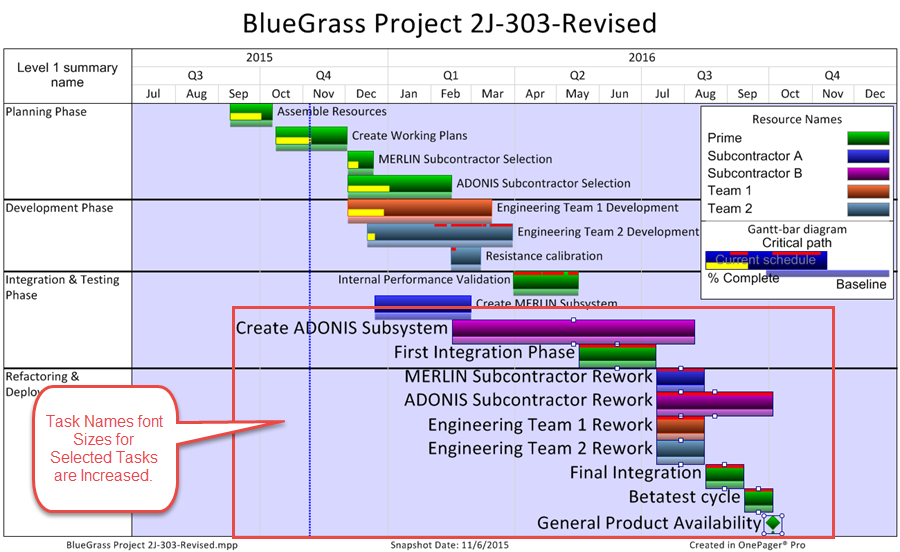
- d) Repeating this operation for the remaining tasks/milestones (we could have done Select Alland done it all at once!), we obtain a project view with larger fonts on all the tasks/milestones:
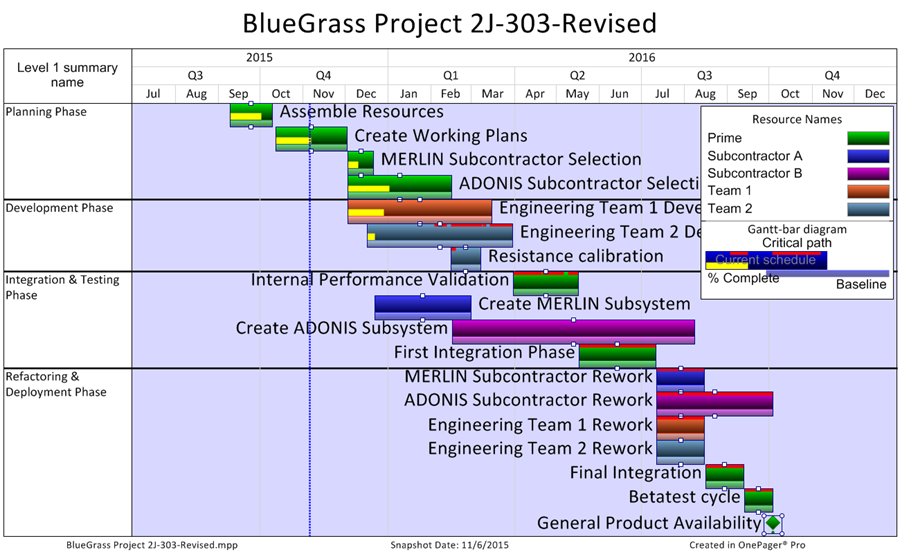
22) Another common editing action is to move the task names from their current position, centered on the task, to a position left or right of the task. To do this, select a set of tasks/milestones as before, but this time click one of the text-positioning buttons on the tool bar:

- a) Doing this on several batches of tasks/milestones results in the following edited project view. (We have also dragged the legend to a new position and have adjusted some of its font sizes):
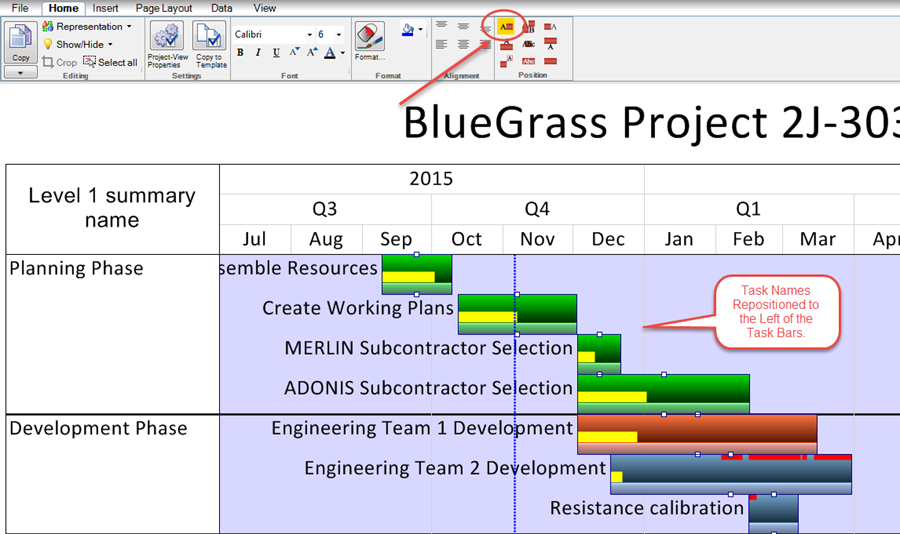
- b) In case you change your mind about the last editing action you took, you can undo the last editing action by clicking the UNDO button above the OnePager tool bar. Successive clicking the UNDO button will undo editing actions in the reverse order that they were applied.
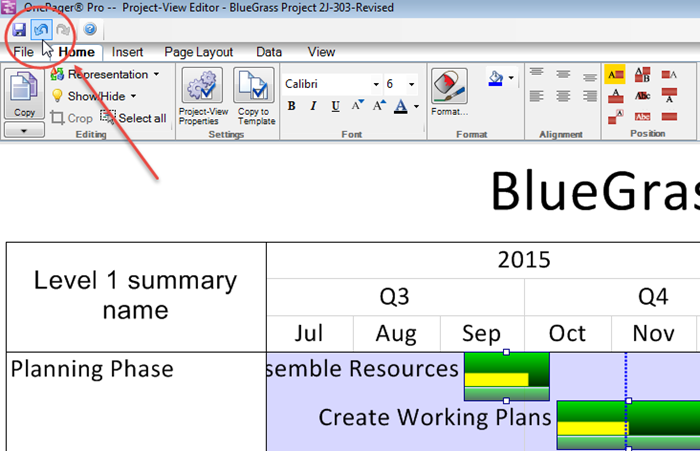
23) Save the edited project view by pressing the Save button above the tool bar next to the UNDO button. All of the font-size changes, text-position edits, and the new legend position are now saved in the file structure in case you need to update this project view with new data at a later time.
Copying the Project View to PowerPoint
24) Finally, copy the current snapshot of the project view to the clipboard by pressing the Copy button on the Home ribbon. Then paste the graph into a PowerPoint slide, as shown below:
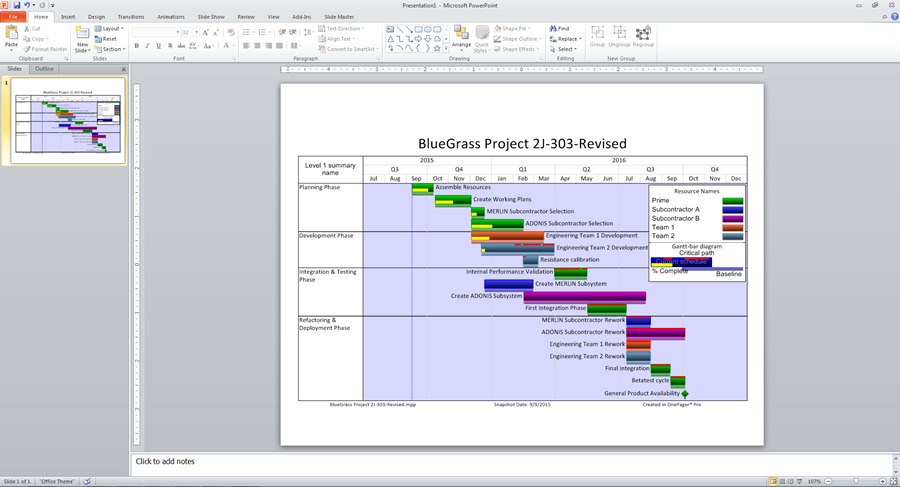
25) TThat’s it! You’ve now created a professional 1-page schedule summary from a complex Microsoft Project schedule and have copied it into a Microsoft PowerPoint presentation. You can also print the graph by selecting the Print button on the File tab. OnePager has other features that let you move tasks vertically to different rows and swimlanes, change the number of swimlanes, add swimlane titles, show dependencies among tasks, change task colors, hide tasks, add floating comment boxes, and standardize on graph styles across organizations. To learn more about these features, read about the specific workflows in this Wiki.
(3.0.2-53)